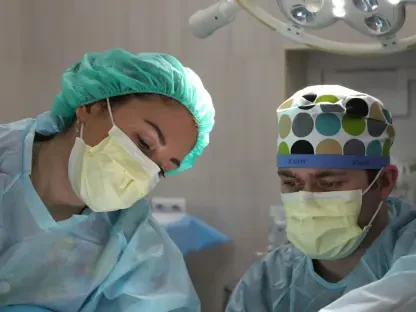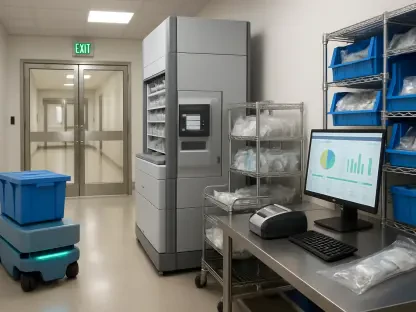Wearable technology is taking considerable strides forward, especially in the realm of women’s health. Historically, patches have been utilized mainly for contraception, hormone replacement therapy (HRT), and menstrual tracking. However, with rapid advancements, these applications have expanded to include innovative solutions like breast ultrasounds and treatments for low libido in post-menopausal women, marking a transformative phase in targeted healthcare through non-invasive wearables equipped with cutting-edge technology.
A Changing Paradigm: Wearable Technology in Women’s Health
The advent of wearable technology is transforming healthcare by facilitating real-time health monitoring, early disease detection, and managing chronic conditions. These non-invasive wearables enable continuous monitoring and remote healthcare, making health data more accessible for both patients and healthcare providers. Projections by GlobalData forecast the wearable technology market to burgeon from $99.5 billion in 2022 to $290.6 billion by 2030, highlighting the increasing adoption of wearables within healthcare protocols. This growth underscores the increasing integration of wearables into healthcare practices, reflecting a future where health monitoring becomes an intrinsic part of everyday life.A sub-sector contributing significantly to this trend is femtech, which is devoted to developing technology-driven solutions for women’s health needs. Patches present a key advantage over other drug delivery mechanisms by offering localized and non-invasive treatment, providing convenience and discretion. This ease of use is especially appealing for women seeking unobtrusive methods of pain relief, such as while working or in public. The development of such technologies represents not just a shift in healthcare approaches but also a move towards personalized and patient-centric solutions that cater specifically to women’s unique healthcare requirements.
Breakthroughs in Early Detection and Preventative Care
Impressive strides are being made in the realm of early detection and preventative care through wearable technology. A poignant example is the breast ultrasound scanner developed by Canan Dagdeviren, an associate professor at MIT’s Media Lab. Inspired by personal loss due to breast cancer, she initiated this groundbreaking project which culminated in an “ultrasound bra.” This innovative device allows women to perform breast scans at home without needing specialized training, using a flexible, 3D-printed patch with honeycomb structures that can image the entire breast.Initial studies demonstrated the patch’s efficacy, successfully identifying cysts as small as 0.3 cm and providing image quality comparable to traditional ultrasounds, reaching tissue depths of up to 8 cm. The ultrasound patch serves as a supplementary tool to standard mammogram screenings, particularly beneficial for women at higher risk of breast cancer by enabling more frequent screenings without radiation exposure. This technology not only aids early disease detection but also alleviates the burden on healthcare systems, providing an initial screening tool for home use, thereby expanding the accessibility of vital diagnostic procedures.The potential applications of this technology extend beyond breast cancer detection. Early detection and preventative care patches could revolutionize how chronic diseases and other serious health conditions are monitored. The ability to conduct at-home diagnostics with patches can empower individuals to take charge of their health more proactively, catching potential issues early and managing them before they escalate into more severe problems. These innovations represent a significant leap in how healthcare can be administered, moving from reactive to proactive care models, which is especially crucial for conditions that benefit from early intervention.
Addressing the Gender Pain Gap with Patch Technology
A significant application of patches in healthcare is addressing the “gender pain gap”—the phenomenon where women’s pain often goes misunderstood or inadequately treated compared to men’s. To mitigate this, developers are creating patches to manage pain associated with conditions like endometriosis and menstrual cramps. For instance, the Myoovi device, a wireless transcutaneous electrical nerve stimulation (TENS) machine, delivers mild electrical impulses via a patch to alleviate abdominal pain, effectively blocking pain signals to the brain and stimulating the release of endorphins.Myoovi, produced by a Manchester-based start-up founded by doctors, offers a solution to inadequacies in current menstrual health management. By providing a non-invasive, drug-free option for pain relief, it addresses the critical issue of chronic pain management in women, specifically targeting an area often neglected by conventional medicine. This novel approach can significantly improve the quality of life for women dealing with these conditions, making it easier for them to manage their symptoms discreetly and effectively.Additionally, BeYou has developed a patch infused with natural ingredients like menthol and eucalyptus for pain relief, lasting up to twelve hours. Unlike conventional medications, these patches provide women with alternative methods to manage pain without reliance on pharmaceuticals or hot water bottles. The infusion of natural, soothing ingredients offers an additional benefit, making the patches not only effective for pain management but also appealing from a holistic health perspective. Such developments are pivotal in providing women more choices for self-care, tailored to their unique health challenges and lifestyles.
Innovations in Hormone Replacement Therapy
Wearable technology’s impact extends to hormone replacement therapy, particularly aiming to address menopausal symptoms. Medherant, a UK-based company, is developing a testosterone patch specifically for post-menopausal women to treat hypoactive sexual dysfunction disorder (HSD). Although testosterone’s role in women’s health is less commonly discussed, it significantly influences libido and cognitive processing, with levels decreasing during perimenopause and menopause.Medherant’s TEPI patch technology effectively delivers testosterone to achieve pre-menopausal blood levels, providing an easy-to-use, mess-free option with better dosage control and minimized risk of transference. Preliminary data from Phase I studies show promising results, with the patch being well-tolerated and demonstrating excellent wearability. The ability to control and restore hormone levels through a simple, wearable patch can greatly improve the well-being and quality of life for women experiencing menopausal symptoms, making hormone therapy more accessible and manageable.Medherant is working with the Medicines and Healthcare products Regulatory Agency (MHRA) to secure regulatory approval and further solidify its place in personalized women’s healthcare solutions. This collaboration underscores the importance of regulatory pathways in bringing innovative healthcare solutions to market, ensuring safety, efficacy, and broader access for patients. Such advancements are crucial in addressing an unmet need in women’s healthcare, where hormone therapies can offer significant benefits but have often been overlooked or underdeveloped.
Future Prospects and Challenges
Wearable technology is making significant strides, particularly in the area of women’s health. Historically, devices like patches were primarily used for contraception, hormone replacement therapy (HRT), and menstrual tracking. However, with rapid advancements in technology, the scope of these applications has broadened significantly. Modern wearables now offer innovative solutions such as breast ultrasounds that can be performed at home, providing a convenient and non-invasive method of early detection and monitoring for breast cancer. Additionally, these devices are now addressing issues previously overlooked, such as low libido in post-menopausal women. This evolution signifies a transformative period in targeted healthcare, making use of non-invasive wearables equipped with the latest cutting-edge technologies.The expansion of wearable technologies in women’s health offers numerous benefits. For instance, they provide easily accessible and personalized healthcare options, allowing women to monitor their health in real-time without frequent visits to a healthcare provider. These advancements also empower women by giving them more control over their health and wellness, whether it’s managing hormonal changes, tracking menstrual cycles, or addressing specific health concerns like libido or breast health. By incorporating advanced features and functionalities, these wearables are setting new standards for how women’s health can be managed efficiently and effectively in the modern world.









